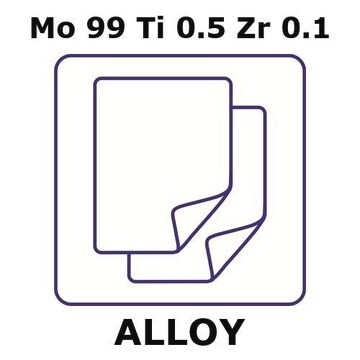266922
Molybdenum
foil, thickness 0.1 mm, ≥99.9% trace metals basis
Sinónimos:
Molybdenum element
About This Item
Productos recomendados
Nivel de calidad
Análisis
≥99.9% trace metals basis
formulario
foil
resistividad
5.0 μΩ-cm, 20°C
grosor
0.1 mm
bp
4612 °C (lit.)
mp
2617 °C (lit.)
densidad
10.3 g/mL at 25 °C (lit.)
cadena SMILES
[Mo]
InChI
1S/Mo
Clave InChI
ZOKXTWBITQBERF-UHFFFAOYSA-N
Categorías relacionadas
Descripción general
Cantidad
Código de clase de almacenamiento
13 - Non Combustible Solids
Clase de riesgo para el agua (WGK)
nwg
Punto de inflamabilidad (°F)
Not applicable
Punto de inflamabilidad (°C)
Not applicable
Equipo de protección personal
Eyeshields, Gloves, type P3 (EN 143) respirator cartridges
Certificados de análisis (COA)
Busque Certificados de análisis (COA) introduciendo el número de lote del producto. Los números de lote se encuentran en la etiqueta del producto después de las palabras «Lot» o «Batch»
¿Ya tiene este producto?
Encuentre la documentación para los productos que ha comprado recientemente en la Biblioteca de documentos.
Los clientes también vieron
Artículos
Combinatorial Materials Science identifies breakthrough materials through systematic exploration, aiding material discovery.
Biomedical implants are essentially foreign substances within the human body that must survive many years’ exposure to demanding mechanical and physiological conditions. Despite these challenges, metal implants have been widely used to substitute for or rebuild hard tissues such as bones and teeth.
Nuestro equipo de científicos tiene experiencia en todas las áreas de investigación: Ciencias de la vida, Ciencia de los materiales, Síntesis química, Cromatografía, Analítica y muchas otras.
Póngase en contacto con el Servicio técnico





